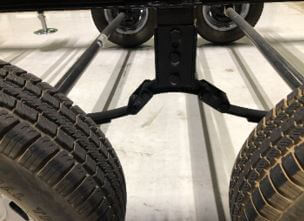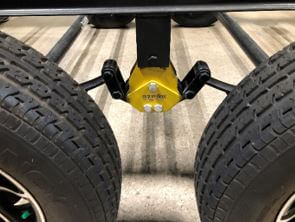By Kevin L. Vaughn
Since my first course on RV Orientation, it has been drilled into my head to “NEVER LET YOUR TIRES/WHEELS DANGLE” after you level your RV. Now, I have to give a disclaimer clarifying that it only applies to motorized RVs.
The rationale behind that guideline is two-fold. First, the suspension of a motorized diesel RV involves airbags, and the manufacturer states they don’t want heavy suspension parts hanging from airbags, even though the leveling jacks can hold the entire weight of the vehicle. Second, with hydraulic levelers, you would only let the suspension and tires hang to bleed the air from the system. Thus, the timed process involves hanging the wheels for only 20 minutes to allow the air to rise to the top of the lines within the system. This is typically done twice to bleed all the air.

As for smaller Class C motorized RVs, I had heard that the lesser-quality leveling jacks used on these were not built to support the entire weight of those vehicles either, and leveling legs were meant to level, not support the vehicle. Blocks under any hanging wheels are recommended to partially support them instead of allowing them to hang freely. In any case, I followed that guideline on my RV for the last four years of travel without incident.
Today, during my last day of classes at the Lippert Technical Institute, a new issue occurred: 5th Wheels and Travel Trailers were parked, allowing their wheels to hang.
When wheels are allowed to hang from the leaf spring shackles, they can flip, as shown below, without any notice, causing an unpredictable and “squirrely ride” for the trailer. Flipped shackles allow excessive movement of the leaf springs and apply inappropriate pressure on the shackle mounts.
If the shackles flip, there is an easy way and one hard way to return them to the correct position. One involves raising the frame with the leveling legs, then gently lifting the axle (just a little to support the axle weight) with a floor jack. Then, you must remove the two shackle bolts & nuts, flip the shackle up, reinsert the bolts, and apply the nuts. The second and more difficult way is to use a long prior bar stuck into the shackle from the bottom. You then pry it upward (which ”may” work).
A few more words of caution in this area were also news to me. NEVER jack your trailer up using a floor jack on the axle. ONLY jack it up on the frame. Serious damage could occur if you attempt to support significant weight on the axle with a floor jack. This comes directly from Lippert, maker of the vast majority of frames for travel and fifth-wheel trailers.

With the extreme summer heat, ensure that your wheel bearings are appropriately greased/lubricated. You should consider using some type of Bearing Buddy device that keeps fresh grease under pressure in the hub. Wheel bearings should be regreased every 12,000 miles, which could be hard to determine since trailers have no odometer.
Finally, when asked how best to stabilize trailers and fifth wheels in the event of storms or high winds, the answer was a resounding “Get OFF the leveling jacks and get the wheels on the ground.” Leveling legs are built to withstand vertical weight support, and they do not have horizontal sway strength. They will easily fold or buckle when pushed horizontally when the wind hits your RV broadside, front or rear.
The Lippert Technical course I attended this week was invaluable. It gave me the hands-on opportunity to see how the base units are built under the watchful eyes of technical specialists.
Jacks Up!…. see you down the road.

